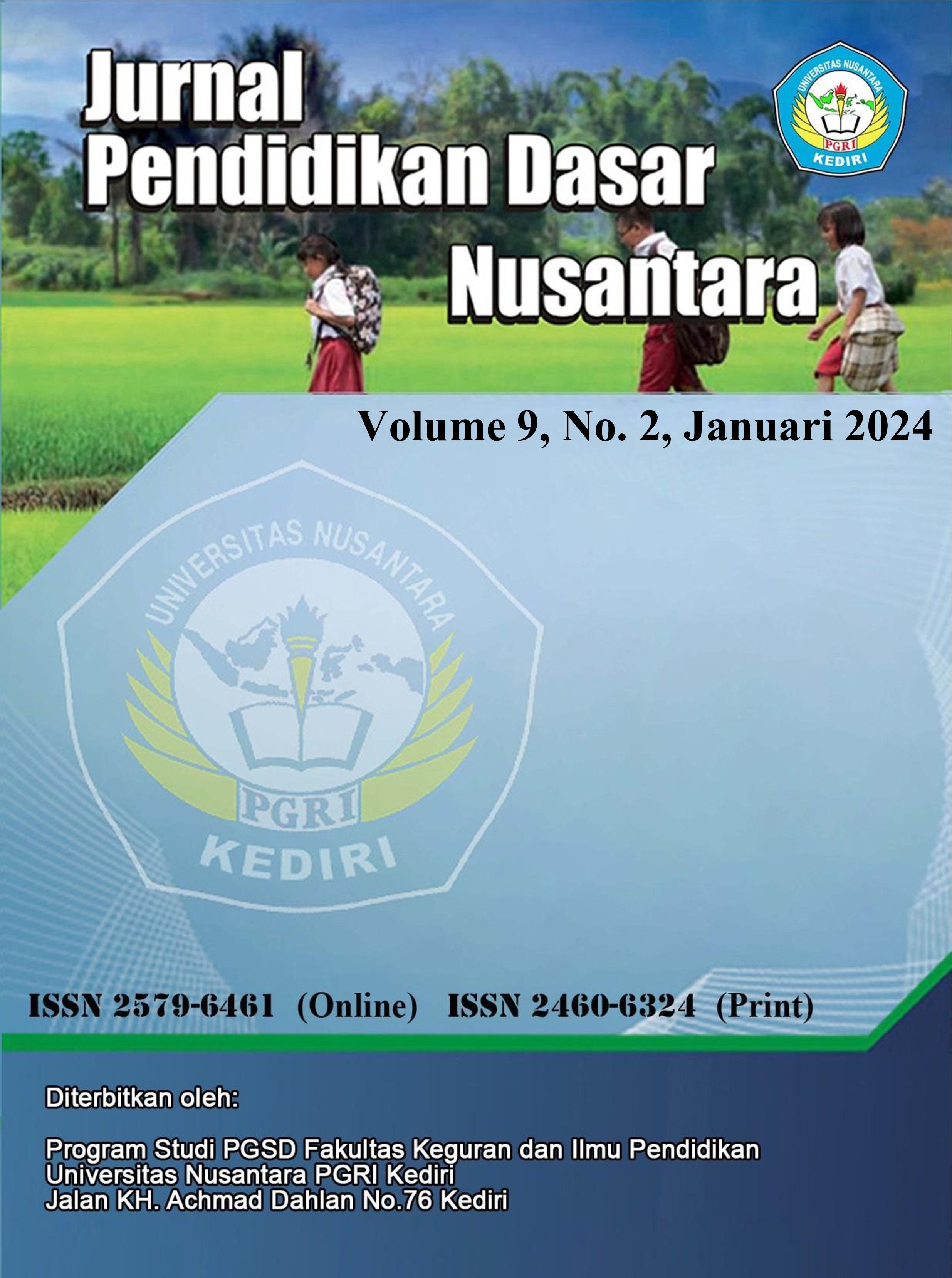Analysis of needs for development of animated video learning media arina expressions based on local wisdom Kediri SDN Burengan II Kediri
DOI:
https://doi.org/10.29407/jpdn.v9i2.22330Keywords:
Needs Analysis, Media Development, Animated VideoAbstract
This research aims to (1) describe the obstacles in developing learning media for animated videos of Arina's expressions based on Kediri local wisdom; (2) describe the need for developing Indonesian language learning media for class II; (3) describe the supporting capacity for developing learning media for animated videos of Arina's expressions based on Kediri local wisdom. The method used in the research was descriptive qualitative with the research subjects being class II students at SDN Burengan 2 with a total of 60 students and 2 teachers at SDN Burengan 2. Data collection techniques used interviews, questionnaires and observation. The analysis technique used is the data triangulation analysis technique (Mills and Huberman) with the stages of data collection data reduction data presentation drawing conclusions. The research results show that 1) There are several obstacles in implementing animated video media, namely teachers prefer textual learning (relying only on textbooks), teachers are not very proficient in operating IT, teachers are more comfortable teaching without using learning media, and teachers still have difficulties in finding suitable media for students. 2) The development of animated video learning media is really needed by class II students at SDN Burengan 2. 3) The supporting capacity in implementing IT-based media is that the principal has facilitated computers and LCDs in implementing IT-based media, the principal provides facilities to help teachers be creative in making media learning, and school principals facilitate workshops/training in making IT-based media such as animated videos. From the results of this research, it is necessary to continue with further research in the form of developing animated video media for Arina's expressions based on Kediri local wisdom at SDN Burengan II Kediri.
Downloads
References
Abdusshomad, A. (2018). Pentingnya Penerapan Pendidikan Karakter Dalam Pembelajaran. Jurnal Asy-Syukriyyah, 19(1), 31–49.
Alwi, Z., Ernalida, E., & Lidyawati, Y. (2020). Kepraktisan Bahan Ajar Perencanaan Pembelajaran Berbasis Pendidikan Karakter Dan Saintifik. Fon : Jurnal Pendidikan Bahasa dan Sastra Indonesia, 16(1), 10.
Delila, K. M., Budiyon. 2020. Pengembangan Media Pembelajaran Video Animasi Materi Bangun Ruang untuk SD Kelas V. JPGSD. 8(5), 1-11.
Depdiknas. 2003. Undang-undang RI No.20 tahun 2003. tentang sistem pendidikan nasional.
Durrotunnisa, & Nur, H. R. (2020). Jurnal basicedu. Jurnal Basicedu,. Jurnal Basicedu, 5(5), 3(2), 524–532. Retrieved from https://journal.uii.ac.id/ajie/article/view/971
Inayati Dika, Rozaq Ardian Putranto. 2023. Terampil Membaca dan Menulis Bahasa Indonesia SD. Semarang: Cahya Ghani Recovery
Juwita Putri, Sutarini. 2024. Bahasa Indonesia SD. Pekalongan: PT Nasya Expanding Management.
Khair, Ummul. 2018. Pembelajaran Bahasa Indonesia dan Sastra (BASASTRA) di SD dan MI. Jurnal Pendidikan Dasar. 2(1). 81-98.
Laila, Alfi.2020. Pengembangan Media Komik Berbasis Kearifan Lokal untuk Menentukan Pesan dalam Dongeng pada Siswa Sekolah Dasar. Jurnal Profesi Pendidikan Dasar.
Lounard Syaulan Sahelatua, L. V. dan M. (2018). Kendala Guru memanfaatkan media IT dalam Pembelajaran di SDN 1 Pagar Air Aceh. Ilmiah Pendidikan Guru Sekolah Dasar, 5(1), 56-63.
Miles, Mattew B. dan Michael Huberman. 1992. Qualitative Data Analysis: A Sourcebook of New Method. Terjemahan Tjetjep Rohendi Rohidi. Analisis Data Kualitatif: Buku Sumber tentang Metode-metode Baru. Jakarta: Penerbit Universitas Indonesia (UI-PRESS)
Ponza, P. J. R., Jampel, I. N., & Sudarma, I. K. (2018). Pengembangan Media Video Animasi Pada Pembelajaran Siswa Kelas IV Di Sekolah Dasar. Jurnal Edutech Undiksha, 6(1), 9–19. Retrieved December 2, 2022, from https://ejournal.undiksha.ac.id/index.php/JEU/article/view/20257
Prasetyo, Y.A. (2020). Pengembangan Media Pembelajaran: Pengembangan Multimedia Interaktif Berbasis Problem Based Learning. Jurnal Ilmu Pendidikan, 5(1), 50–54.
Primayana, K. H. (2022). Implementasi Pendidikan Karakter Dalam Pembelajaran Bahasa Indonesia di Sekolah Dasar. Cetta: Jurnal Ilmu Pendidikan, 5(1), 50–54.
Susilo Herawati. 2022. Study Lesson Berbasis Sekolah. Malang: Bayu Media Publishing
Sukatin, S., Munawwaroh, S., Emilia, E., & Sulistyowati, S. (2023). Pendidikan Karakter dalam Dunia Pendidikan. Anwarul, 3(5), 1044–1054.
Relis, A., Nurul, U., Sumarno. 2018. Pengembangan Media Pembelajaran Video Animasi Dua Dimensi Situs Pekauman di Bondowoso Dengan Model Mata Pelajaran Sejarah Kelas X IPS. Jurnal Edukasi, 5(1), 19-23.
Santrianawati. 2018. Media dan Sumber Belajar, Sleman: CV Budi Utama.
Wicaksono Andri, Fahrurozi. 2023. Pengembangan Pembelajaran Bahasa Indonesia di Sekolah Dasar. Sleman: Garudhawaca
Wulandari, A. P., Salsabila, A. A., Cahyani, K., Nurazizah, T. S., & Ulfiah, Z. (2023). Pentingnya Media Pembelajaran dalam Proses Belajar Mengajar. Journal on Education, 5(2), 3928–3936.
Zagita K, Moh Zukifli. 2022. Semua Bisa Pintar Ulangan Harian Tematik SD/MI Kelas 2. Jakarta: PT Grasindo
Zaini, H., & Dewi, K. (2017). Pentingnya Media Pembelajaran Untuk Anak Usia Dini. Raudhatul Athfal: Jurnal Pendidikan Islam Anak Usia Dini, 1(1), 81–96.
Downloads
Published
Issue
Section
License
Authors who publish with this journal agree to the following terms:
- Copyright on any article is retained by the author(s).
- The author grants the journal, the right of first publication with the work simultaneously licensed under a Creative Commons Attribution License that allows others to share the work with an acknowledgment of the work’s authorship and initial publication in this journal.
- Authors are able to enter into separate, additional contractual arrangements for the non-exclusive distribution of the journal’s published version of the work (e.g., post it to an institutional repository or publish it in a book), with an acknowledgment of its initial publication in this journal.
- Authors are permitted and encouraged to post their work online (e.g., in institutional repositories or on their website) prior to and during the submission process, as it can lead to productive exchanges, as well as earlier and greater citation of published work.
- The article and any associated published material is distributed under the Creative Commons Attribution-ShareAlike 4.0 International License

































